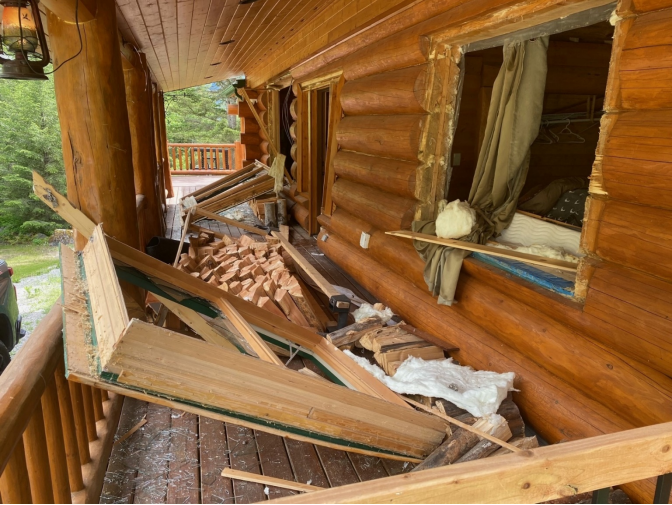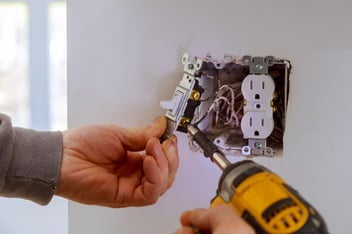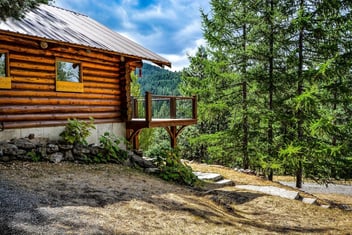Home renovation season is right around the corner, and we know you’re itching to get started on your dream renovation as soon as possible.
Before you rush in, though, it may be helpful to take a deep breath and pause to consider a few of the ways in which a home renovation might not go your way. We understand it’s probably not the most exciting aspect of renovation planning, but keeping safety top of mind will always pay off in the long run.
Learn from these seven mistakes that we’ve seen homeowners make again and again, and find out how you can keep your dream home makeover from becoming a nightmare.
7 Home Renovation Mistakes Everyone Should Know About (With Real Incidents)
1) Hiring an Unlicensed Contractor
When you’re deep into your home renovation and costs are beginning to balloon out of control, it might be tempting to go with a cheaper unlicensed contractor over a licensed contractor.
Licensed contractors play an important role in our safety system by ensuring that regulated work is performed correctly and safely. However, unlicensed workers continue to advertise and perform regulated work. Each year in BC, we investigate multiple incidents caused by unsafe conditions created by unqualified workers. This can result in costly repairs after the fact and serious risks and hazards.
In a recent incident in Spillimacheen, BC, an unlicensed contractor was hired to replace a residential gas fired hot water tank. The contractor left the gas line uncapped without notifying the homeowner. When the gas was turned on, it resulted in an explosion that blew out the front windows of the cabin and pushed out the front wall. While no injuries resulted, it caused serious damage to the property.
2) Following an Oversimplified DIY Video
The tutorial you found on YouTube makes it seem easy enough. Cut a few holes in the wall, move around some wires, and you’ll have brand new light switches installed in no time. You might even save a few bucks by not purchasing permits or hiring a licensed contractor. But there can be some downsides to DIY videos.
When consulting home renovation videos ask yourself these questions before proceeding:
- Does the individual providing instructions have the appropriate education/certification and knowledge to provide home renovation training?
- Are there differences between your home and the home in the tutorial that may need to be considered?
- Do you have access to the specific specialized tools and safety gear needed to do the job? (Substituting tools can increase the risk of damage or injury.)
- If something does go wrong and there is an unexpected outcome, are you prepared for it? If you lack experience or knowledge about a topic (e.g., electrical currents), you may not be aware of the appropriate safety procedures, which could lead to serious injuries.
We strongly encourage anyone in need of home renovations to enlist the services of a qualified professional (you can find one using our Find a Licensed Contractor tool.
3) Conducting Unpermitted Work and Using Improper Equipment
If you’re an inexperienced DIYer, you may not be aware of the complexities and hazards associated with electrical and gas installations or renovations. Homeowner permits are important because they give you assurance from a safety officer with significant technical and industry expertise to ensure that the installation or renovation is safe.
In addition to making sure a permit is obtained, make sure you have the right equipment to protect yourself from hazards. Depending on your project, you may need a hardhat, safety goggles, gloves, or all of the above.
4) Not Getting Your Home up to Code
If you have an older home, it’s likely that someone in the past has used a shortcut or two in their own renovations. These unpermitted workarounds may not necessarily be a safety concern, but they could require changes to get them up to code again. If you’re doing your own renovation without full awareness of these past DIY jobs, they could easily go unnoticed, which could incur hidden costs in the future.
Pro-tip: Because licensed contractors keep up with the latest code, they will be able to spot these types of “fixes” immediately and can make recommendations and estimates on the most headache-free and cost-effective ways to get your home up to code.
5) Unpermitted Installations of Emerging Technologies
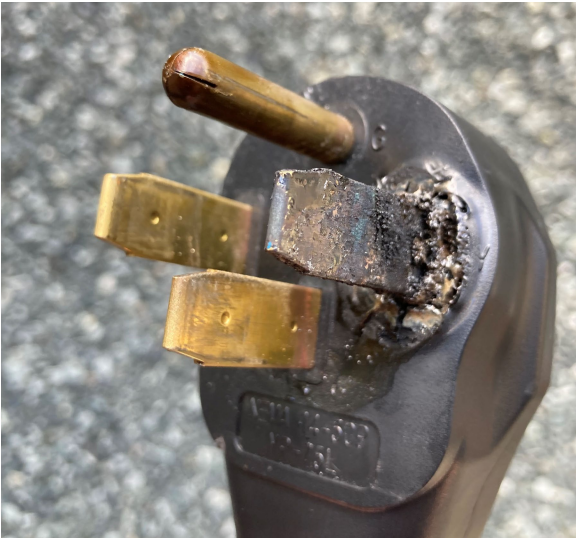
Updating older homes with the latest low-carbon technologies — like solar panels, heat pumps, and electric vehicle chargers — makes for an excellent investment, both for your home and for the planet. But because these technical systems are still quite new, an installation by an unqualified professional can lead to problems.
A recent incident we investigated involving an electric vehicle charger highlights what can go wrong when an unpermitted installation isn’t performed by a qualified professional.
In Port Alberni, a homeowner was charging their electric vehicle in their garage. As the vehicle was charging, the receptacle and inserted plug began to heat up. When the homeowner returned to the garage, they identified a burning smell which was traced to the receptacle supplying the Electric Vehicle Supple Equipment (EVSE). The homeowner immediately disconnected the cord from the receptacle before a fire could occur.
The EVSE unit had been installed without a permit by a previous owner of the home. Luckily, no one was injured in this incident.
Ready to pull a permit for your home reno?
6) Installing a New Appliance Without Considering Hazards it May Pose
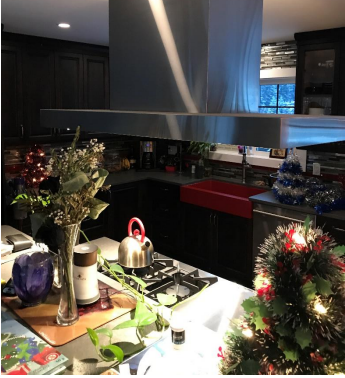
In rare cases, installing a new kitchen appliance which might not seem particularly complex or unsafe can create a very severe problem. In a recent incident that occurred in Fraser-Fort George, BC, four people were taken to hospital with carbon monoxide poisoning, likely due to the addition of a new exhaust hood over the range, which created a lack of combustion air and freshly ventilated air.
It is likely that due to the insufficient fresh air entering the house during the operation of the kitchen exhaust fan, prolonged operation of the furnace with no CO detectors and an overall negative air pressure condition in the house combined to create this hazardous CO atmosphere. Due to the furnace conditions, it allowed the high concentration of carbon monoxide to be distributed throughout dwelling.
This depressurization state created by the installation of the new exhaust fan was only discovered after a Technical Safety BC safety officer conducted a thorough investigation of the home.
7) Improper Installations
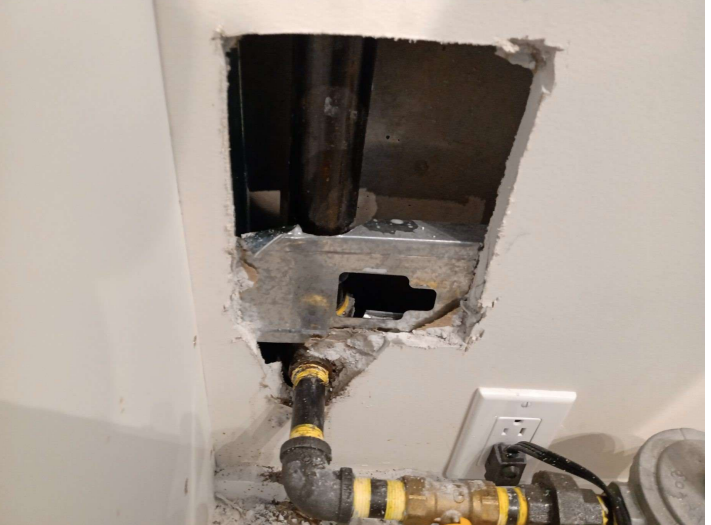
DIY installations may occur without incident. But sometimes an improper installation can happen without the installer finding out until it’s too late. One common issue we see with renovations involves nailing, drilling, or screwing into covered walls without knowing what’s behind the wall.
In a recent incident in an apartment in Burnaby, BC, a contractor was installing a wall mounted microwave. Prior to installation, the installer used a stud finding device which indicated metal in the wall that, unknown to the installer, was actually a natural gas pipe. Believing it was a steel stud, they drilled holes in the drywall and punctured the natural gas line, which caused natural gas to release through the holes and into the apartment over the next six days.
Eventually, the occupant of the apartment reported a rotten egg smell, which was subsequently confirmed during testing by a gas utility representative. The occupant stated that the gas range was operated in the apartment on multiple occasions prior to the identification of the leak by the gas utility technician, but luckily, it did not ignite the leaking gas, and no one was injured.
Our safety officers have investigated several incidents resulting from nails, drills, or screws puncturing or damaging concealed gas lines or electrical conduits. To prevent this, we recommend planning ahead, identifying concealed services, and using extreme caution when penetrating a concealed wall.
Conclusion
If you’ve made it this far, you may have noticed a trend developing. A safe home renovation largely depends on the expertise and technical knowledge of licensed contractors, as well as the assurance provided by safety officers via renovation permits. Avoiding incidents like the ones outlined above requires doing your due diligence but also relying on others who know how to perform work correctly and safely.
Take the risk out of your renovation.

